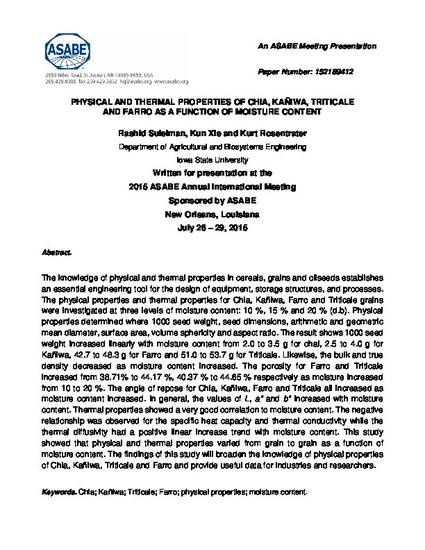
The knowledge of physical and thermal properties in cereals, grains and oilseeds establishes an essential engineering tool for the design of equipment, storage structures, and processes. The physical properties and thermal properties for Chia, Kañiwa, Farro and Triticale grains were investigated at three levels of moisture content: 10 %, 15 % and 20 % (d.b). Physical properties determined where 1000 seed weight, seed dimensions, arithmetic and geometric mean diameter, surface area, volume sphericity and aspect ratio. The result shows 1000 seed weight increased linearly with moisture content from 2.0 to 3.5 g for chai, 2.5 to 4.0 g for Kañiwa, 42.7 to 48.3 g for Farro and 51.0 to 53.7 g for Triticale. Likewise, the bulk and true density decreased as moisture content increased. The porosity for Farro and Triticale increased from 38.71% to 44.17 %, 40.37 % to 44.65 % respectively as moisture increased from 10 to 20 %. The angle of repose for Chia, Kañiwa, Farro and Triticale all increased as moisture content increased. In general, the values of L, a* and b* increased with moisture content. Thermal properties showed a very good correlation to moisture content. The negative relationship was observed for the specific heat capacity and thermal conductivity while the thermal diffusivity had a positive linear increase trend with moisture content. This study showed that physical and thermal properties varied from grain to grain as a function of moisture content. The findings of this study will broaden the knowledge of physical properties of Chia, Kañiwa, Triticale and Farro and provide useful data for industries and researchers.
Available at: http://works.bepress.com/rashid_suleiman/2/
This proceeding is from 2015 ASABE Annual International Meeting, Paper No. 152189412, pages 1-33 (doi: 10.13031/aim.20152189412). St. Joseph, Mich.: ASABE. Posted with permission.